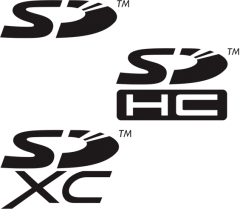What do SD, SDHC, and SDXC Flash Memory Card Standards Signify?
 There are four main families of SD Card products with three related to memory devices. The SD interface has become the go to interface for most consumer devices and it's making some inroads to the industrial flash storage market as well.
There are four main families of SD Card products with three related to memory devices. The SD interface has become the go to interface for most consumer devices and it's making some inroads to the industrial flash storage market as well.
SD refers to the original Standard Capacity SD Card. SDHC refers to SD High Capacity and SDXC represents SD eXtended-Capacity.
There is also a non-memory standard called SDIO for SD IO Devices with wide ranging functions such as Wi-Fi, GPS, Cameras, FM Radio, Bluetooth, Digital TV Tuner, Scanner, Voice Recorder and others.
SD Standards, Specs and Logos
SD Standard Capacity
 2GB and lower Capacities
2GB and lower Capacities- FAT12 and FAT16 File System
- SD, miniSD and microSD form factors supported
- Cactus Industrial Grade SD and microSD Cards support this standard
SD High Capacity
 From 4GB to 32GB in Capacity
From 4GB to 32GB in Capacity- FAT32 File System
- SD, miniSD and microSD form factors supported
- Sometimes represented as SDHC, microSDHC
- Cactus Industrial Grade SD and microSD Cards and Industrial MLC SD Cards support this standard
SD eXtended-Capacity
 From 64GB to 2TB in Capacity
From 64GB to 2TB in Capacity- exFAT File System
- SD, miniSD and microSD form factors supported
- Sometimes represented as SDXC, microSDXC
- Cactus Industrial MLC SD Cards support this standard






